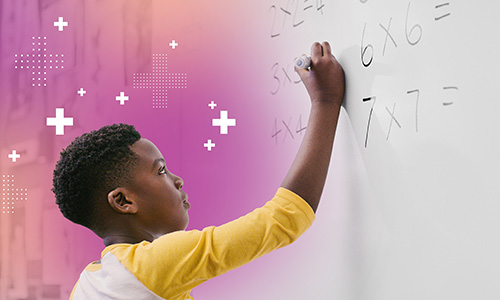
In an earlier blog post, I proposed a framing for what it means to learn mathematics. I claimed that, at a minimum, learning mathematics involves:
- Ways of thinking that are empowered by…
- Habits of thinking, along with an ability to make sense of and use some…
- Ways of doing, to do something bigger with mathematics.
Ways of thinking and habits of thinking are critical yet easily undervalued, and if you’re a math teacher, you may be looking for ways to increase your classroom’s focus on them. Formative conversation starters can help. But first, let’s make sure we’re on the same page about what ways and habits of thinking are.
Understanding ways and habits of thinking in mathematics
Here’s a quick example for ways of thinking to refresh your memory. Imagine the question “How many years was it from December 7, 1941, to December 7, 2021?” Take a moment to think about an answer and how you arrived at your solution.
Did you try it? You likely had no difficulty answering that question, and you probably used ways of thinking rather than ways of doing to find the answer. That is, you probably thought about the numbers as quantities with meaning, and how you needed to compare the years to find the gap between them, and that the comparison you needed was a sort of subtraction problem.
Perhaps you recalled that you can find the answer to a subtraction problem without using a traditional subtraction algorithm. For example, you may have “added up” from 1941 to 2000, then added 21 to that number. Another strategy you may have employed is to shift the problem down one year, knowing that finding the years between 1940 and 2020 would provide the same answer and the numbers would be more friendly.
[M]ost of us experienced mathematics instruction that tilted strongly toward ways of doing, with less (if any) emphasis on ways of thinking and habits of thinking.
You were likely able to relate many concepts and had some habits (or practices) that helped you realize that the procedure (the way of doing) would have been less efficient, unnecessary, and perhaps more prone to error. (Did you ever realize that we borrow but never give back?) Ways of thinking about comparisons and operations such as subtraction and addition enable you to own a math problem. Math instruction, then, must go beyond just teaching ways of doing if we truly want students to understand it and be able to own their math problems, too.
The case for more than just doing
There’s some overlap with my take on learning mathematics and that taken by the National Mathematics Advisory Panel in 2008. There, the panel claimed the following: “To prepare students for Algebra, the curriculum must simultaneously develop conceptual understanding, computational fluency, and problem-solving skills. Debates regarding the relative importance of these aspects of mathematical knowledge are misguided. These capabilities are mutually supportive, each facilitating learning of the others.”
I think, though, that I’m nudging at something more than conceptual understanding—as I want to aim for not just grasping concepts, but making sure those concepts fit into deeply connected schemes of thinking. The debate over the importance of each is indeed misguided, as in some contexts a procedural approach might be more efficient and less prone to error. If someone asks me how much I’ll make after working 143 hours at $34 per hour, I might just grab a pencil if one is handy and blaze through a multiplication algorithm. I’d leverage a way of doing.
Ways of thinking about comparisons and operations such as subtraction and addition enable you to own a math problem.
So, instead of stressing that one aspect of learning may be more important than another, I’ll instead take the position that each has its place in math instruction. Historically, though, we know that most of us experienced mathematics instruction that tilted strongly toward ways of doing, with less (if any) emphasis on ways of thinking and habits of thinking. With that, the need is great to strengthen those areas in our professional discourse and practice.
Making sense of student thinking
Although we tend to engage in math instruction through grade-level standards, mathematical ways of thinking are enduring and transcend grade levels. A sixth-grade student should still use the ways of thinking about division that were cultivated in earlier years as they engage in the division of fractions. Division of fractions is still division, after all. It isn’t something new.
What do I mean by this? Well, think about how many times you have honestly used division of fractions in real life. Be careful with the cooking connection. Halving a recipe? That’s probably not dividing by ½, but multiplying by ½. Why is it so tough? I’d claim because division of fractions, as taught, is too often disconnected from ways of thinking and is presented only as a way of doing. Doing without thinking results in a nifty skill that stands disconnected; it’s all alone.
Understanding student ways of thinking requires opportunities to listen for that thinking. And it involves tasks that can elicit that thinking. It also requires deciding what to listen for.
Suppose we want to work on division of fractions in seventh grade. It matters how the students come to class thinking about fractions, how they are thinking about operations—particularly division—and how they think about negative numbers. If we attend to just the algorithm of “invert and multiply,” we miss helping students see connections and we miss ways to further strengthen existing ways of thinking.
Listening to students’ responses to questions like the following can help us better understand student thinking and inform our math instruction:
- Is a fraction one number or two numbers?
- In mathematics, what does division do for us?
- Without computing, what is one meaning of division you can use to make sense of 10 ÷ 1/5?
- Without computing, what is one meaning of division you can use to make sense of (-10) ÷ 1/5?
- Without computing, describe how you can estimate the value of (-10) ÷ (-0.3) using division as comparison (copies of, or times, as large language).
Did you try some of these? Were you able to answer them? If so, did you notice consistency in your answers in the cluster on division? Did they make you think? Were you able to bring meanings to these questions in the same way that you brought meaning to my opening question about transpired years?
Such questions can work well in the formative space of instruction. We might treat them as opportunities to challenge ourselves and our students. They respect the thinking that students bring with them, and they can be presented as discussion prompts rather than as a race to being right or wrong.
Understanding student ways of thinking requires opportunities to listen for that thinking. And it involves tasks that can elicit that thinking. It also requires deciding what to listen for.
The above questions come from our new formative conversation starters for math instruction. In them, we outline Big Ideas to Nurture Standards Sensemaking (BINSS) that transcend grade levels and develop over time. These BINSS help us narrow down what to listen for. From there, we provide a few hundred pages of formative activities and supports, grouped in question clusters, to invite discussion and reveal student thinking. It’s a turnkey set of resources we hope you find helpful to develop new habits of thinking through talking about how we are thinking.







